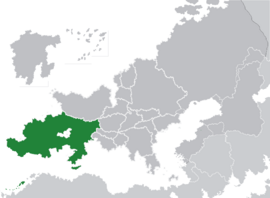Eulabia
This article is incomplete because it is pending further input from participants, or it is a work-in-progress by one author. Please comment on this article's talk page to share your input, comments and questions. Note: To contribute to this article, you may need to seek help from the author(s) of this page. |
Commonwealth of Eulabia | |
|---|---|
| Motto: "Towards a New Eulabia We March Ever Forwards" | |
| Anthem: "Brothers of Eulabia" | |
 | |
| Capital and largest city | Lunden |
| National language | English |
| Regional languages | French • Italian • Spanish • Dutch • German |
| Ethnic groups |
|
| Demonym(s) | Eulabian |
| Government | Unitary[a] semi-presidential republic under a triumvirate |
• President | Oswald Mosley |
• Prime Minister | Mekhar Asul Karlsson |
• Commander-in-Chief | Christopher Fairfax |
| Legislature | Eulabian Parliament[b] |
| Establishment | |
• Eulabian Defence Community | 1948 |
• Treaty of Kostanse | 1958 |
• Commonwealth of Eulabia | 9 May 2012 |
| Population | |
• 2023 census | 220,369,846 |
| GDP (nominal) | 2023 estimate |
• Total | |
• Per capita | |
| Gini (2023) | medium |
| HDI (2023) | very high |
| Currency | Eulabian franc (EF) |
| Date format | dd/mm/yyyy (AD) |
| Driving side | right |
| Calling code | +44 |
| Internet TLD | .eu |
The Commonwealth of Eulabia commonly known as Eulabia, the Commonwealth or EAN, is a sovereign country located in Eulabia. Eulabia covers (land area) square kilometres land border with Theedishland, Gadyaria, Transteslania and Raditia and has an estimated population of 220 millions.
The Commonwealth emerged from the Eulabian Civil War. A new constitution was adopted, which established a unitary semi-presidential system. Since 2013 Eulabia's political system has been dominated by Oswald Mosley, under whom the country has experienced democratic backsliding and a shift towards authoritarianism. The Commonwealth possesses the largest stockpile of nuclear weapons and has the fifth-highest military expenditure in Kali Yuga. The country is a permanent member of the ISAAC Security Council; a member state of the ECC, ETO and PRMP.
History
Early histoy
Cavallo and 19th century (1799–1936)
Cavallian Empire
The Cavallian Empire, is a historical term used to describe the dominion of a Vitulian military commander Carlo Cavallo over several Eulabian states from 1806 to 1818. It is considered a precursor to the modern Eulabian state. Although not a legal entity per se, the empire was a de facto confederation of nominally independent states of Sallia, Vitulia, and Belgae, each retaining own governments but unified under Cavallo’s leadership.
Carlo Cavallo, born in 1769 in Vitulia, swiftly rose through the military ranks and had crucial role in defeating Sallen forces during the Vitulian unification wars between 1792 and 1798. By 1799, Cavallo, recognised for his leadership and fairness, was appointed Military Overseer of Sallia, where he curtailed the revolutionary excesses and initiated liberal reforms, earning him election as President of Sallia in 1803.
In 1806, amid political upheaval in Vitulia, Cavallo led a coup that overthrew the Consulate, resulting in his appointment as President of Vitulia. His dual presidency sent shockwaves through Eulabian monarchies forming the First coalition and began a period known as the Cavallian Wars. During the Cavallian Wars Cavallo’s grande armée expanded its influence across most of Eulabia and established several sister republics. These victories led to the worldwide expansion of Western Eulabian revolutionary ideals and reforms, such as the metric system, Cavallian Code and Declaration of the Rights of Man.
Cavallo’s ground campaigns from 1808 to 1812 marked the peak of the Cavallian Empire. However, his ambitions eventually led to overreach. Naval defeat against the Aeyariss Imperial Navy in 1809, and the failed invasion of Rostovia between 1814 and 1816 signalled the beginning of the empire’s decline. In 1817, facing a new grand coalition of monarchist powers, Cavallo was forced into a conditional surrender that restored or annexed various territories of the Cavallian Empire to neighbouring states.
Cavallo continued to serve as President of Sallia until 1818, when attempts by the Sallen Parliament to extend his term indefinitely were vetoed by Cavallo in favour of new elections. His refusal to accept the monarchist offer of the Sallen Crown led to his overthrow in a coup, marking the end of his rule in Sallia. In Vitulia, Cavallo faced a similar challenge in 1819 when the parliament attempted to grant him dictatorial powers for life. Disapproving of this move towards dictatorship, Cavallo resigned, but his resignation was initially refused by parliament. Ultimately, he forcibly ended his mandate, leading to the appointment of the Vice President as his successor.
Cavallo retired to the secluded island of Lagosta, where he lived out his remaining years until his death in 1829. He is remembered as a principled leader and a brilliant strategist whose commitment to republican ideals and effective governance had a lasting impact on the political development in [[Eulabia (region)|Eulabia.
Post-Cavallo period
Sallo-Vitulian Confederation
Great War (1936–1948)
Western Eulabian Defence Community
Eulabian Union
Civil War
Commonwealth of Eulabia
Geography
TBD
Government and politics
The Commonwealth, by 2012 constitution, is a unitary republic with a semi-presidential system, wherein the president is the head of state, and the prime minister is the head of government. It is structured as a multi-party representative democracy, with the commonwealth government composed of three branches:
- Legislative: The tricameral Eulabian Parliament, made up of the 800-member National Assembly, TBD-member Council of Corporations and 18-member Harmony Council, adopts laws, declare war, approves treaties, has the power of the purse and the power of impeachment of the president.
- Executive: The president is the supreme commander-in-chief of the Armed Forces, and appoints the Government of Eulabia and other officials, who administer and enforce commonwealth laws and policies. The president may issue decrees of unlimited scope, so long as they do not contradict the constitution or the commonwealth law.
- Judiciary: The Constitutional Court, Supreme Court and lower national courts, whose judges are appointed by the Harmony Council on the recommendation of the president, interpret laws and can overturn laws they deem unconstitutional.
The president is elected by popular vote for a six-year term and can be reelected once consecutively. Ministers of the government are composed of the prime minister, senior ministers (secretaries of state) and other junior ministers (ministers of state or undersecretaries of state); all appointed by the president on the recommendation of the prime minister (excluding the Defence Secretary who is recommended by the Commander-in-chief of the Armed Forces). National Party of Eulabia is the dominant political party in Eulabia, and has been described as the “party of power”. Under the administrations of Oswald Mosley and so called triumvirate, the Commonwealth has experienced democratic backsliding.
Triumvirate System
During the turbulent period of the Eulabian Civil War in 2008, a de facto political system emerged known as the triumvirate. This informal pact was initially formed as a pragmatic pact between key figures in state administration, military leadership, and corporate interests, aimed at stabilising and governing Eulabia amidst the conflict and its immediate, chaotic aftermath. The original members of the triumvirate were Oswald Mosley, representing the state, Pablo Badoglio, representing the military, and Ulrich Karlsson, representing corporations.
Following the civil war, the initial transitional intent of the triumvirate extended indefinitely. As of 2024, the triumvirate members are; Oswald Mosley as President, Christopher Fairfax as Commander-in-Chief, and Mekhar A. Karlsson as Prime Minister.
Political divisions
The Commonwealth, under its 2012 constitution, is structured as a devolved unitary state. This represents a significant change from the former Eulabian Union, which was legally a federation and the member states of the Eulabian Union were semi-sovereign entities with the right to secede.
In contrast to the federation model, the current structure of the Commonwealth does not feature member states; instead, the former member states have been reorganised into Countries. These Countries enjoy a considerable degree of autonomy and have their own legal systems. Their autonomy is not constitutionally guaranteed but is granted by parliamentary law. As such, it can be adjusted, revoked, or otherwise modified by the Eulabian Parliament. Unlike their predecessors in the Eulabian Union, these Countries are not sovereign entities, cannot declare sovereignty, secede from the Commonwealth, or enact laws that conflict with the Commonwealth legislation.
| Name | Flag | Capital | Legislature | Executive | Population | GDP | |||
|---|---|---|---|---|---|---|---|---|---|
| Number | % | nominal (billion) | % | per capita | |||||
| Sallia | Lunden | Sallen Parliament | Sallen Government | 85,780,639 | 39% | 3,237 | 40.7% | 37,731 | |
| Vitulia | Rema | Vitulian Parliament | Vitulian Government | 66,411,650 | 30.1% | 2,239 | 28.17% | 33,719 | |
| Tauridia | Salamanca | Taured Parliament | Taured Government | 27,490,392 | 12.5% | 859 | 10.8% | 31,265 | |
| Belgae | Konstanse | Belgic Parliament | Belgic Executive | 22,874,932 | 10.4% | 921 | 11.6% | 40,270 | |
| Ostara | Argeburg | Ostaran Parliament | Ostaran Government | 17,470,380 | 7.9% | 675 | 8.5% | 38,684 | |
| Lorraine | Meyenbourg (de facto) | Lorraine Parliament | Lorraine Government | 361,423[c] | 0.2% | 17 | 0.2% | 45,819 | |
| Commonwealth | Lunden | Eulabian Parliament | Eulabian Government | 220,369,846 | 100% | 7,959 | 100% | 36,117 | |
Notes
- ↑ devolved
- ↑ The legislature consists of three chambers:
- Harmony Council
- Council of Corporations
- National Assembly
- ↑ controlled

